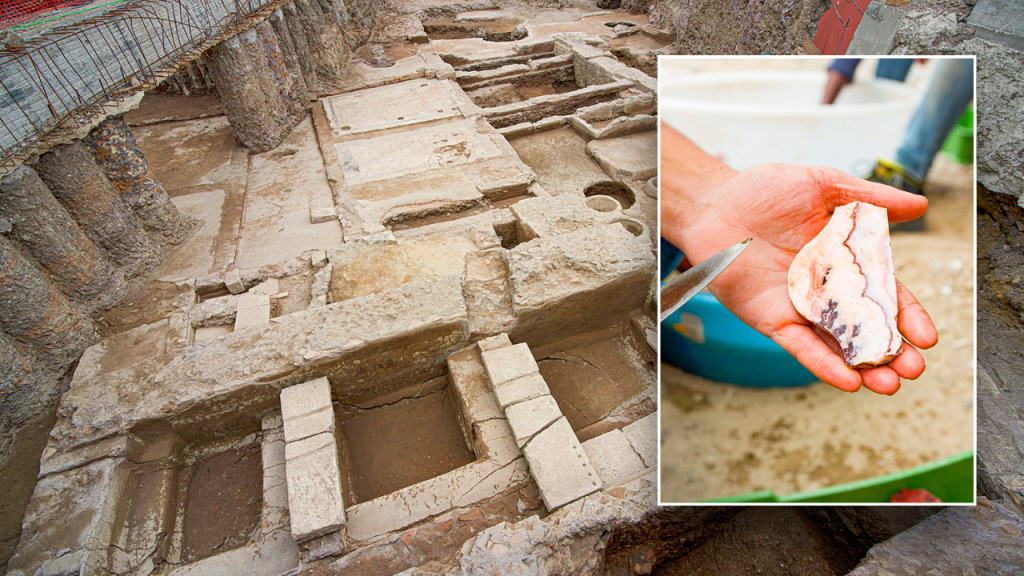Construction workers in Italy recently discovered the site of an ancient laundry near the Vatican during construction efforts at Piazza Pia, a Roman square that is being pedestrianized. The Ministry of Culture in Italy announced the surprising findings, which included ancient tiled floors and tubs for washing clothes. Archaeologists also found ceramic shards from destroyed artifacts and pits that may have been used as baths. The site was likely built as an imperial residence overlooking the Tiber River with arcades, walks, and gardens between the second and third centuries. It eventually became a fullonica or laundry where launderers used urine as a detergent. Romans would bring their dirty laundry to the fullonica to be cleaned, despite generally looking down on the profession for its unhygienic methods.
The discovery of the ancient laundry site in Rome has provided insight into the lives of ancient Romans and their hygiene practices. Launderers in ancient Rome used human and animal urine as a detergent, collected from public restrooms, to clean clothes in a process that involved treading on the cloth to remove stains and odors, similar to a modern washing machine. The profession continued for hundreds of years after the fall of the Roman Empire until the modern age when soap replaced urine as a cleaning agent. Despite the unhygienic methods, launderers were paid well for their services, and Romans would pay to have their dirty laundry cleaned at a fullonica, reflecting the importance of cleanliness and personal hygiene in ancient Roman society.
Archbishop Rino Fisichella expressed his gratitude and nostalgia for the recent discovery of the fullonica, stating that it brought him back in time to the meeting place of the people, particularly the women of that era. The site has allowed researchers to uncover more about the daily lives and practices of ancient Romans, shedding light on the ways in which they maintained personal hygiene and cleanliness. The fullonica was an important part of Roman society, despite the general disdain for its methods, as it provided a valuable service to citizens who sought clean clothes. The recent discovery has sparked interest in the archaeological community and has the potential to reveal more about ancient Roman culture and society.
The site of the ancient laundry near the Vatican has been described as an imperial residence that featured arcades, walks, and gardens with a scenic view overlooking the Tiber River. The Roman square at Piazza Pia where the discovery was made is being pedestrianized, allowing for further archaeological exploration and preservation of the site. The ancient fullonica functioned as a laundry where urine was used as a detergent to clean clothes, reflecting the hygiene practices of ancient Romans. The discovery of tubs, ceramic shards, and pits at the site provides valuable insight into ancient Roman daily life and the importance of cleanliness in society.
The construction workers who made the discovery at Piazza Pia in Rome have unearthed a significant archaeological site that sheds light on the daily practices of ancient Romans. The fullonica located near the Vatican was a place where Roman citizens brought their dirty laundry to be cleaned using urine as a detergent. Despite the unhygienic methods, launderers were paid well for their services, indicating the importance of cleanliness in ancient Roman society. The recent discovery of the ancient laundry site has sparked interest and gratitude from Archbishop Rino Fisichella and researchers, offering a glimpse into the past and the ways in which Romans maintained personal hygiene and cleanliness. The site has the potential to reveal more about Roman culture and society through further archaeological exploration and preservation efforts.
The Ministry of Culture in Italy announced the surprising findings of the ancient laundry site near the Vatican, which was uncovered during construction efforts at Piazza Pia. The discovery included ancient tiled floors, tubs for washing clothes, ceramic shards from destroyed artifacts, and pits that may have been used as baths. The site was likely an imperial residence overlooking the Tiber River with arcades, walks, and gardens, and later became a fullonica or laundry where urine was used as a detergent to clean clothes. The recent discovery has provided valuable insight into ancient Roman daily life and hygiene practices, highlighting the importance of cleanliness in society. The fullonica served as a meeting place for the people, particularly the women of that era, and played a significant role in Roman society, despite being viewed unfavorably for its unhygienic methods.


